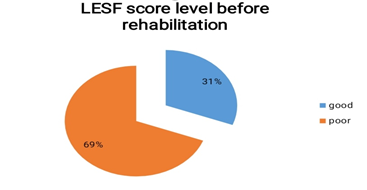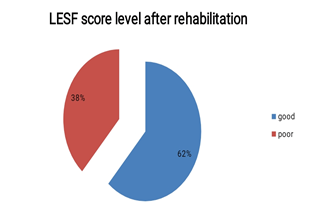Effect of the Rehabilitation Program on the Lower Limbs Function after Anterior Cruciate Ligament Reconstruction Surgery: Case Series from Sudan, Khartoum, 2018-2019
Ethar Hajo Ahmed Elsheikh1*, Suad Mohamed Ali2
15th Year Medical Student, Faculty of Medicine, University of Khartoum, Khartoum, Sudan
2Consultant community Medicine, Assistant Professor, Department of Community Medicine, University of Khartoum, Khartoum, Sudan
*Corresponding author: Ethar Hajo Ahmed Elsheikh, 5th Year Medical Student, Faculty of Medicine, University of Khartoum, Khartoum, Sudan
Received: 01 October 2020; Accepted: 08 October 2020; Published: 21 Octobert 2020
Article Information
Citation: Ethar Hajo Ahmed Elsheikh, Dr. Suad Mohamed Ali. Effect of the Rehabilitation Program on the Lower Limbs Function after Anterior Cruciate Ligament Reconstruction Surgery : Case Series from Sudan, Khartoum, 2018-2019. Archives of Physiotherapy and Rehabilitation 3 (2020): 068-075.
View / Download Pdf Share at FacebookAbstract
Objectives: To assess the effect of the rehabilitation program on the lower limbs function after anterior cruciate ligament reconstruction surgery.
Design: A case- series hospital-based study.
Setting: The study was conducted in Khartoum state at the Safana physiotherapy and rehabilitation complex at the East Nile Model Hospital from the first of January 2018 to the thirty first of December 2019.
Participants: 13 participants were studied with ACL injuries, aged from 15 to 45 years.
Main outcome measures: The data was collected using the Lower Extremity Functional scale, it comprises 20 items, each item has a score of 5-points (0-4).
Results: Revealed that 9 participants out of 13 had a bad scores before the rehabilitation program and the rest 4 had good scores. After the completion of the program 8 participants had good scores while 5 had bad scores. There is a significant statistical association between the scale scores before and after the rehabilitation (p-value 0.001) and between the participants’ age and the scale scores after the rehabilitation (p-value 0.001). There is also a significant statistical association between the number of sessions and the scores after the rehabilitation (p-value 0.001).
Conclusion: The results revealed the beneficial and crucial role of the rehabilitation program in the lower limbs function restoration.
Keywords
Knee, ACL, Reconstruction, Rehabil-itation, LEFS
Article Details
1. Introduction
It is the largest joint in the body. Basically it consists of two condylar joints, the first is a synovial joint of a hing variety between the femur and tibia, being partly divided by menisci with the lateral and medial surfaces being asymmetrical, the distal surface of the medial one is narrower and more curved than the lateral condyle while the lateral surface is almost rounded, and these differences appear in the shape of the menisci. The second is a synovial joint of the plan gliding variety between the patella and the femur [1, 2]. The ligaments at the knee joint can be divided into extracapsular ligaments which are the ligamentum patellae, lateral and medial collateral ligaments and the oblique popliteal ligament [1]. The tibial collateral ligament (medial) is a flat triangular ligament attached to the medial femoral epicondyle above and to the upper part of the medial surface of the tibia below. The fibular collateral ligament (lateral) is a cord like ligament attached above to the lateral epicondyle and to the head of the fibula below. The oblique popliteal ligament is expansion of the tendon of semimembranosus which blend with the capsule above and the head of the fibula below. The arcuate popliteal ligament is a Y-shaped thickening of the capsule attached to the head of the fibula, posterior edge of the tibial intercondylar area and the lateral femoral condyle [2]. The other divisions the intracapsular ligaments which are the posterior and anterior cruciate ligaments and the menisci [1].
The cruciate ligaments are pair of ligaments connecting the tibia to the femur, lying within the capsule but not within the synovial membrane. The anterior cruciate ligament (ACL) attached to the tibia between the attachment of the anterior horns of the medial and lateral meniscus and twist to attach posteriorly to the posteromedial aspect of the lateral femoral condyle [2]. The posterior cruciate ligament (PCL) is stronger, attached to the posterior part of the tibial intercondylar area and to the anterolateral aspect of the medial femoral condyle. The cruciate ligaments Cross each other [2]. The menisci or the semilunar cartilages lie in and attached to the tibial plateau, they are mainly avascular but their peripheral zone is vascularized from the capsule. The bone contributes little to the stability, the inter condylar eminence of the tibia prevents side-slipping of femur on tibia. Ligaments and muscles contribute much to the stability which rarely dislocated. The cruciate ligaments are responsible for the anteroposterior stability in flexion. The forward displacement is prevented by the ACL while the backward displacement is prevented by the PCL [2]. Anterior cruciate ligament injury(ACL) injury occurs from both contact and non-contact injury. The most common mechanism of contact injury is a blow to the lateral side of the knee resulting in a valgus force to the knee. While the most common mechanism of non-contact injury is a rotational mechanism in which the tibia is extremely rotated on the planted foot. The second most common mechanism is forceful hyperextension of the knee [3]. Acute sprains and partial ligament tears can be treated conservatively with rest, joint protection and exercise. After the acute stage of healing exercise should be geared to regain the normal ROM, balance control, normalization of gait and strengthening the muscles that support and stabilize the joint during the normal activities [3]. The healing capacity of a torn ACL is poor, giving rise to the frequent need for surgical reconstruction to retain the knee stability particularly in young active individuals. A rehabilitation program is started after the reconstruction to obtain full activity [3].
Rehabilitation also known as physical medicine is a branch of medicine with a goal of restoration and enhancement of the functional ability and quality of life of those with physical disabilities and impairments. In rehabilitation the cool is set by the clinical care team to provide the rehabilitation team and the person undergoing the rehabilitation a direction to work. As the emphasis in the rehabilitation is optimization the quality of life rather than restoration of the pre- disability functional status [4]. The stability of the knee joint depends on the strength of the thigh muscles and the tone of the joint ligaments of which the anterior cruciate ligament is the most important, so injury of this ligament disturbs the stability of the joint and produce disability to injured knee. The disability after (ACL) injury and the reconstruction surgery is the recalling need for rehabilitation for those patients to continue their normal life activities. This study aims to assess the lower limbs function after the rehabilitation program after (ACL) reconstruction and determine its beneficial role in decreasing and eliminating the disability and identify its role in the clinical outcome and patient’s satisfaction. The results of this study can be of value to the Physiotherapist and the athletes.
2. Methodology
2.1 Study design
Case series facilityl-based study.
2.2 Study area
The study was conducted in Sudan, Khartoum state, East Nile locality at the Safana physiotherapy and rehabilitation complex at the East Nile Model Hospital. This hospital especially receives all orthopedic cases and neurological cases. The center has thirteen patients’ rooms and works all the working days of the week with two shifts, day and night.
2.3 Study population
The population included patients with ACL injuries and who had undergone reconstruction surgery and completed a rehabilitation program at the Safana physiotherapy and rehabilitation complex at the East Nile Model Hospital, whose Age was from 15 to 45 years.
2.3.1 Exclusion criteria: Patients with pure injuries of the menisci or other collateral ligaments. Those who were younger than 15 years and older than 45 years were excluded.
2.4 Sampling
All ACL reconstruction patients who complete their rehabilitation program at the Safana physiotherapy and rehabilitation complex at the Nile East model hospital at the time of the study (2018 – 2019).
2.5 Data collection tools
Data is collected using Standard scale questionnaire.
2.6 Data collection method
The data was collected using a standardized, pre-tested
pre-coded, self reported scale questionnaire, on phone calls-based. The questionnaire is a standardized self-reported Lower Extremity Functional scale, used in evaluation of the lower extremity functional status of an individual with functional problems , it comprises 20 items, each item has a score of 5-points (0-4). The items are summed giving a total score of 80 . The higher the better score is the functional status. The scale is reliable and valid as an assessment tool. The minimum detectable change is 9-scale points [5].
2.7 Data analysis
The data has been analyzed using software package for statistical analysis (SPSS) version 23.
2.8 Ethical considerations
The author reports no conflicts of interest in this work. An approval from Community medicine department, Faculty of medicine, University of Khartoum was obtained.
2.9 Limitations
The total number of ACL reconstruction patients undergoing rehabilitation program in the Safana physiotherapy and rehabilitation complex at the Nile East model hospital was 42 and as the data information had been collected from the participants by phone calls only 13 patients were reached.
3. Results
3.1 Socio- demographic characteristics of the study population
The study included 13 participants, all of them were males (100%), (Table 1). The maximum age was 39 years and the minimum was 21 years , with the mean age of approximately 27.77, (Table2). Eight of the participants were employees (61%) , three were free workers (23.1%) and the remaining two, one was student and the other is not working (7.7%), (Table3). The level of education was university for 12 participants (92.3%) and only one was a post-graduate (1%), (Table
4).
3.2 The LEFS score before the rehabilitation
The mean of the LEFS before the rehabilitation program for the all 13 participants was found to be 0.1587 with standard deviation of 0.24348 . So 4 participants (31%) were found to be above the mean (good score), while 9 participants (69%) were found to be below the mean (bad score), (Figure1).
3.3 The LEFS score after the rehabilitation
The mean of the LEFS score after the rehabilitation program for the all 13 participants was found to be 0.8125 with standard deviation of 0.18639 . So 8 participants were found to be above the mean (good score), while 5 participants were found to be below the mean (bad score), (Figure 2).
3.4 The difference in the LEFS score before and after rehabilitation
The difference between the participants LEFS before and after the rehabilitation program, all found to be greater than 9 which is the minimal clinically detectable change in lower limb functions according to the LEFS. Using one of the nonparametric tests called the wilcoxon singed-rank test because there is a violation of the normality regarding the paired T-Test , the median differences between the participants LEFS score before and after the rehabilitation equals 0 , providing significant association with P-value of 0.001.
3.5 The effect of age on the LEFS score after the rehabilitation
Using one of the nonparametric tests called the wilcoxon singed-rank test because there is a violation of the normality regarding the paired T-Test , the median differences between the participants LEFS score after the rehabilitation and their age equals 0 , providing significant association with P-value of 0.001.
3.6 The effect of the number of sessions on the LEFS scores after the rehabilitation
The mean of the sessions number the participants attend
was found to be (16.4615).Using one of the nonpara-
metric tests called the wilcoxon singed-rank test because there is a violation of the normality regarding the paired T-Test, the median differences between the participants LEFS score after the rehabilitation and the number of sessions they attend equals 0 , providing significant association with P-value of 0.001.
|
Variables |
Frequency |
Percent |
|
Males |
13 |
100% |
|
Females |
0 |
0.00% |
Table 1 : Sex distribution of the participants at the Safana complex (N=13).
|
Variables |
Frequency |
Percent |
|
15-25 |
3 |
23.1% |
|
25-45 |
10 |
76.9% |
Table 2: Age distribution of the participants at the Safana complex (N=13).
|
Variables |
Frequency |
Percent |
|
No work |
1 |
7.7% |
|
Student |
1 |
7.7% |
|
Employee |
8 |
61.5% |
|
Free worker |
3 |
23.1% |
Table 3: Occupation of the participants at the Safana complex (N=13).
|
Variables |
Frequency |
Percent |
|
University |
12 |
92.3% |
|
Postgraduate studies |
1 |
7.7% |
Table 4: Education of the participants at the Safana complex (N=13).
4. Disscussion
The rehabilitation program after the Anterior Cruciate Ligament reconstruction surgery has an important role in the patient’s clinical outcome and satisfaction. The rehabilitation programs after anterior cruciate ligament injury have evolved in parallel with the understanding of the structure and biomechanics of the knee and the development in the reconstruction techniques. Retain of the knee function and return of the patients to pre injury activities successfully is the key elements to assess the rehabilitation clinical outcomes. In this study we use the Lower Extremity Functional Scale (LEFS) to assess the clinical functions of the lower limbs before the beginning of the rehabilitation program, which reveals that 9 of the total 13 participants have bad scores and the rest 4 participants have good scores, these results are aligned with the results of a study of Short-Term Outcome of Multi-Ligament Knee Injury among Sudanese Patients, which found that 16 of the participants who had reconstruction after the injuries had an excellent, good and fair scores of the Lyshlome knee scoring scale, while the 6 who didn't have the reconstruction surgery had a bad Lyshlome knee scoring scale scores [6]. Then the lower functions were reassessed after the completion of the rehabilitation program, revealing that significantly 8 of the participants regain their normal function and have good (LEFS) scores, while only 5 have bad scores . This improvement in the function after the rehabilitation program support the recommendation that mentioned in the above study of implementation of a postoperative physiotherapy to improve the outcomeafter knee injury [6].
As the clinically detectable change was represented in the LEFS as an increase of 9 degrees in the score, all of the participants scored high above 9 degrees. This indicates that the program has made a clinically detectable improvement in the lower limbs functions of all the participants. The results showed that the participants improved scores after the rehabilitation program were significantly associated with their age , this significantly pointed out that young participants and athletes have higher chances for functional recovery and retain their normal knee joint function after the rehabilitation program, which correlated with the finding of the study of Younger Patients and Men Achieve Higher Outcome Scores Than Older Patients and Women After Anterior Cruciate Ligament Reconstruction that showed higher functional performance and clinical scores for younger patients [7]. Involvement of other age groups in upcoming studies can be beneficial to support or role out that opinion. Although the study doesn’t address the designed rehabilitation program for the participants, it significantly showed that there is strong association between the number of sessions the participants had and their after program scores, and as they all adhere to a mean of sessions of (16.4615) during their programs, this imply that the more the number and adherance to the sessions and exercise the better the outcome. These results emphasize the the results of the study of Rehabilitation adherence and anterior cruciate ligament reconstruction outcome, which said that the more the adherence to thepostoperative rehabilitation the better the functional outcomes after ACL reconstruction [8].
5. Conclusion
The LEFS scores of the participants after the rehabilitation were better than those before the rehabilitation, with statistical association of p-value =0.001. There is a significant association between the participants’ LEFS scores after the rehabilitation and their age, young patients and athletes had better results. There is a significant association between the participants’ LEFS scores and the number of sessions they had attended, more sessions had given better out come.
Recommendations
The researcher recommends that this program should be implemented in all centers that might deal with similar problem. More studies should be conducted involving larger sample size with different age groups.
Conflict of Interest
Authors declare no conflict of interest in this research. There is no involvement of any organization or entity with any financial or non-financial interest in the subject matter of this manuscript.
References
- Snell R. Clinical anatomy for medical students. 7th ed. Philadelphia: Lippincott Williams & Wilkins (2004).
- Last's anatomy regional and applied. 12th ed. Edinburgh: Churchill Livingstone (1994).
- Kisner C, Colby L, Borstad J. Therapeutic exercise. 4th ed (2018).
- Physical medicine and rehabilitation. En.m.wikipedia.org (2019).
- Physiotherapy Following Acl Reconstruction Protocol (2015).
- Ali A, Abdelwahab M. Short-Term Outcome of Multi-Ligament Knee Injury among Sudanese Patients. Open Access Macedonian Journal of Medical Sciences 7 (2019): 1486-1493.
- Mouton C. CORR Insights®: Younger Patients and Men Achieve Higher Outcome Scores Than Older Patients and Women After Anterior Cruciate Ligament Reconstruction. Clinical Orthopaedics and Related Research 475 (2017): 2481-2483.
- Brewer B, Cornelius A, Van Raalte J, et al. Rehabilitation adherence and anterior cruciate ligament reconstruction outcome. Psychology, Health & Medicine 9 (2004): 163-175.



 Impact Factor: * 1.3
Impact Factor: * 1.3 Acceptance Rate: 73.39%
Acceptance Rate: 73.39%  Time to first decision: 10.4 days
Time to first decision: 10.4 days  Time from article received to acceptance: 2-3 weeks
Time from article received to acceptance: 2-3 weeks 